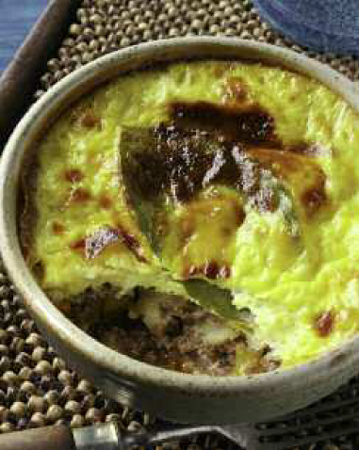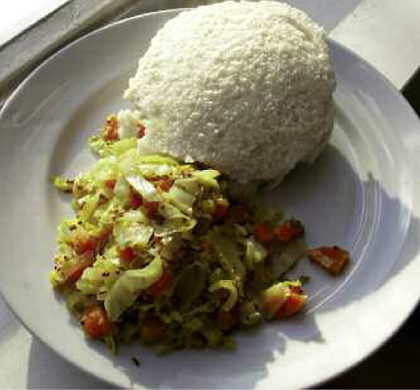5
Africa

She was nothing special, she wasn’t merry
She wasn’t even very pretty
But I see her in front of her stove
And I smell her delicious bobotie.
The cooking pots taught me
Bobotie is quite a job
If you don’t know the art
And without my wife
I’ll never manage the recipe.
Ddisselblom, ‘Bobotie’
Africa has been a meeting ground for many civilizations. Arab traders visited the east coast as early as the second century AD. The Portuguese began exploring the coast of Africa in 1419 in search of a sea route to the source of the lucrative spice trade; in 1488 Bartolomeu Dias rounded the Cape of Good Hope. The Portuguese retained their colonies in Angola and Mozambique until the 1970s. Meanwhile, the Dutch and the British developed a strong presence, especially in southern and eastern Africa.
South Africa
South African food is often described as a ‘rainbow’ cuisine that mirrors the country’s diverse ethnicities: Dutch (later called Afrikaaner), British, French, Malaysian, Indian and African.
In 1651 the Dutch East India Company established a settlement at the Cape of Good Hope to provide food and supplies for ships sailing between the Netherlands and the Dutch East Indies – a seventeenth-century truck stop. The colonists, who came from Dutch, French Huguenot and German stock, established permanent settlements and brought in slaves from Indonesia and India to work on their farms and in their kitchens.1 They and their descendants became known as Cape Malays (Malay was the lingua franca of trade). Today, an estimated 180,000 Cape Malays live in South Africa, mainly in Cape Town.
In 1806 the British took control of the Cape and the colonists moved north in the Great Trek to settle in what became the provinces of Orange Free State, Transvaal and KwaZulu Natal. The British brought in 150,000 indentured labourers to work on their sugar, banana, tea and coffee plantations. Most were from southern India; a smaller group came from Bihar, Orissa and Uttar Pradesh. From the 1880s onwards they were joined by Indian businessmen, traders and lawyers (including a young Mahatma Gandhi). Many of these ‘passenger Indians’ came from Gujarat on India’s west coast. They opened small restaurants and shops to sell spices and Indian condiments.
Celebrated for their cooking skills, the Cape Malays were much in demand as cooks in the early Dutch settlers’ homes. Trade links with Indonesia ensured a supply of aromatic spices that were used with a free hand in stews, curries (called kerries), sausages and baked goods. By the middle of the eighteenth century, the dominant cooking style bore little resemblance to that of Holland and ‘owe[d] as much to the East as to the West’.2
Several Cape Malay dishes became such a part of the South African way of life that the South African writer Laurens van der Post called them ‘almost sacramental substances’.3 Bobotie is a dish of finely minced beef or lamb, flavoured with curry powder (the original version was made with fresh spices), onions, garlic and lemon leaves, topped with a savoury custard and baked in the oven. It often includes almonds, raisins and apricots. There are many variations, including some made with fish. A classic recipe is found in Hildagonda Duckitt’s (1840–1905) pioneering collection Hilda’s ‘Where is it?’ of Recipes, which was first published in 1891 and went through many editions. Her book also includes recipes for chicken curry, a cucumber curry (made with minced mutton, bread and curry powder) and sosatie. From the Malay words for skewered meat and spiced sauce, sosatie is a mutton kabob marinated in onions, curry powder, chillies, garlic and tamarind water and roasted on skewers over an open fire.
One of the classic dishes of South African Cape Malay cuisine, bobotie. |
Another popular South African Cape Malay dish, sosatie.
Another classic South African/Cape Malay dish is bredie, a tomato and lamb stew made by sautéing onions, meat and vegetables, adding chillies and spices such as ginger, coriander, cinnamon and cloves, and then simmering in a cast-iron pot to create a thick curry-like stew. An edible water lily called waterblommetjie is often added. Another hybrid is a koeksister, a deep-fried fritter served in a sugar syrup flavoured with ginger, cardamom and cinnamon – a combination of an Indian gulab jamun and a European pastry.
Curries, or kerries, are enjoyed by all sections of the population in South Africa, including Zulus, the largest ethnic group. They are flavoured with both freshly ground fresh spices and Malay-style curry powder, which is generally milder than Indian-style curries; fruit is a common ingredient. Hilda Gerber’s Traditional Cookery of the Cape Malays (1957) includes recipes for giema (keema or minced meat) kerrie; groema kerri seasoned with a special curry powder (not described) sold in Indian shops; bahia kerri flavoured with star fennel; and pinang kerri flavoured with lemon leaves. Kerries are served with atjars, Indian-style vegetable pickles; blatjang, a chutney-like condiment of Indonesian-Malay origin made with apricots, quinces and raisins; sliced bananas; chutneys; sambals, side dishes of grated fruit or vegetables with chillies; and rice.
The most famous Indo-South African dish is bunny chow, a meat curry served in a hollowed-out loaf of Western-style bread. |
In her compilation Indian Delights (published in the early 1960s), Zuleikha Mayat wrote that most of the Indian immigrants to South Africa came from poor rural backgrounds, which was reflected in their cookery. Lentils, beans, rice, flour rotis and mealie rice (crushed corn kernels boiled to look like rice) were dietary mainstays. The Hindu Gujaratis, who arrived as ‘passenger Indians’, were generally more affluent and enjoyed a more upmarket cuisine; the Muslim Gujaratis elaborated the preparation of meat dishes, ‘making subtle distinctions between different grouping of condiments and producing sensitively different aromas and eating experiences’. The recipes in the chapter called ‘Curries’ mirror these diverse traditions.
The most famous Indo-South African dish is bunny chow, a meat curry served in a hollowed-out loaf of Western-style bread. One explanation of its name is that in Durban Indian merchants were often called banias, the name of a caste of traders. They opened small restaurants that blacks could not enter because of apartheid but where they could (illegally) be served at the back door. An enterprising restaurant owner got the idea of hollowing out a small loaf of bread, pouring in curry, topping it with Indian pickles and handing it over to the customer without cutlery. The dish was named bunny chow, from ‘bania chow’.
Under apartheid, Cape Malay food was rarely served in mainstream hotels and restaurants but it was available in Malay ‘cook shops’ specializing in kerriekerrie on Cape Town’s side streets. Today, fortunately, there is no shortage of South African restaurants serving traditional Cape cuisine.
Other African Countries
Indian, and later Arab merchants came to East Africa for cloves, nutmeg, cinnamon and pepper. The North African traveller Ibn Battuta, who visited Mogadishu (now in Somalia) in 1331, describes a dinner that sounds much like a modern Indian meal:
Their food is rice cooked with ghee placed on a large wooden dish. They put on top dishes of kushan – this is the relish, of chicken and meat and fish and vegetables. They cook banana before it is ripe in fresh milk and they put it on a dish, and they put sour milk in a dish with pickled lemon on it and bunches of pickled chilies, vinegared and salted, and green ginger and mangoes . . .
Ugali is Swahili for a porridge-like dish made from corn meal that is a staple in southern and eastern Africa. It is rolled into a ball and dipped in a meat, vegetable or fish curry.
When they eat a ball of rice, they eat after it something of these salted and vinegared foods . . . Now one of these people of Maqdashaw habitually eats as much as a group of us [Moroccans] would. They are extremely large and fat of body.4
The Portuguese established colonies in what are today Angola, Equatorial Guinea, Madagascar, Mozambique and Zanzibar. They introduced chillies, corn, tomatoes, sweet potatoes, cassava and the domestic pig from the New World; salt cod from Portugal; citrus fruits from their Asian colonies; and spices such as cloves, cinnamon and ginger from West Africa and India. Both the Portuguese and British brought Goans to their colonies as artisans and clerical workers. The Goan influence can be seen in the use of coconut milk as the gravy for many African dishes, especially those made with seafood.
A traditional meal in most of Africa is a thick porridge (made from boiled yam roots, plantains, corn, millet, sorghum or rice) eaten with a stew or sauce. The components vary by region but usually consist of oil, a vegetable and a small amount of protein (fish, meat, legumes, nuts). This pattern lends itself well to the adaptation of curry dishes. In East Africa, curry is typically made with chicken, goat or mutton and served with Indian-style bread or cornmeal (ugali in Swahili), pounded and boiled until it is very thick. Every household has a large tin of curry powder (mchuzi) on hand; chillies, called peri peri in Swahili, are grown everywhere. Mchuzi is also the name given to popular Zanzibar vegetable, meat, fish or seafood curry made with tomatoes, coconut milk, tamarind and curry powder and accompanied by bananas, pickles and either rice or chapattis (a bread that is popular in East Africa). Roast meat, called nyama choma, flavoured with curry powder, is another popular dish.
Peri peri chillies are tiny super-hot chillies popular in many parts of Africa.
In 1888 the British established the Imperial British East Africa Company to develop trade in the region and later set up the Protectorate British East Africa, encompassing present-day Kenya and Uganda. Between 1896 and 1901, 30,000 labourers from India were recruited to build the Uganda Kenya railway. They were followed by other immigrants, mainly Gujaratis, who were moneylenders, traders and shop owners. By the mid-1960s, 360,000 people of Indian origin lived in East Africa, but most were forced to leave by new nationalist governments and emigrated to Britain and Canada. With regime changes in Uganda and Kenya, many have returned and today run grocery stores and small stands selling samosas, curry and other Indian dishes. Large cities like Mombasa and Kampala have many Indian restaurants.
Curries, called carils, are popular dishes in Mozambique and Angola, which were Portuguese colonies until the mid-1970s. According to Van der Post, Angolan curries tend to be ‘either straightforward derivatives of the curries of India or pale imitations of those of South Africa, particularly Natal’. The Mozambican national dish is peri peri (also known as pil-pil and pili-pili), made by simmering freshly picked peri peri chillies in lemon juice, salting the mixture and pounding it into a paste, which is spread over meats, fish and shellfish. The dish spread to other parts of Africa and even to Portugal and Goa.
Curry powder and other spices are popular seasonings in Ethiopia and Eritrea, where stews (wats) eaten with the flatbread called injera are the national dish. The Ethiopian seasoning berbere, used in many dishes, can contain ginger, onion, garlic, cloves, cinnamon, nutmeg, cardamom pods, spice black pepper, fenugreek, coriander and very hot chillies. Curry powder is an ingredient in many dishes in West Africa, especially Nigeria, where it was brought by the British administrators in the colonial period.




